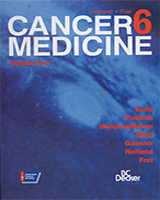By agreement with the publisher, this book is accessible by the search feature, but cannot be browsed.
NCBI Bookshelf. A service of the National Library of Medicine, National Institutes of Health.
Kufe DW, Pollock RE, Weichselbaum RR, et al., editors. Holland-Frei Cancer Medicine. 6th edition. Hamilton (ON): BC Decker; 2003.

Holland-Frei Cancer Medicine. 6th edition.
Show detailsThe molecular characterization of tumor antigens has allowed a better understanding of the genetic events that may give rise to tumor-specific antigens. In particular, tumor-specific antigens may be encoded by a primary open reading frame of gene products that are differentially expressed by tumors, and not by normal tissues (Figure 12-4). They may also be encoded by mutated genes, intronic sequences, or translated alternative open reading frames, pseudogenes, antisense strands, or represent the products of gene translocation events.12–20

Figure 12-4
Subcellular sources of tumor antigens. Tumor-associated antigens (TAA) can derive from any protein or glycoprotein synthesized by the tumor cell. TAA proteins can reside in any subcellular compartment of the tumor cell; ie, they may be membrane-bound, (more...)
This topic of the categorization of tumor antigens has been systematically addressed by a number of excellent reviews.21–24 Tumor antigens can be loosely categorized as oncofetal (typically only expressed in fetal tissues and in cancerous somatic cells), oncoviral (encoded by tumorigenic transforming viruses), overexpressed/ accumulated (expressed by both normal and neoplastic tissue, with the level of expression highly elevated in neoplasia), cancer-testis (expressed only by cancer cells and adult reproductive tissues such as testis and placenta), lineage-restricted (expressed largely by a single cancer histotype), mutated (only expressed by cancer as a result of genetic mutation or alteration in transcription), posttranslationally altered (tumor-associated alterations in glycosylation, etc.), or idiotypic (highly polymorphic genes where a tumor cell expresses a specific “clonotype”, ie, as in B cell, T cell lymphoma/leukemia resulting from clonal aberrancies). Examples of tumor-associated antigens that fall into each of these categories are provided in Table 12-1.
Table 12-1
General Categories and Examples of Tumor Antigens.
It should be stressed that these categories are not mutually exclusive and tumor antigens may fall into more than one category. For example, the p53 tumor-suppressor gene product is frequently mutated in cancer cells, resulting in the accumulation of p53 protein in these cells in concert with reduced cell-cycle regulatory control by the tumor cells. Based on these parameters, p53 would then be simultaneously classified as both an overexpressed/accumulated tumor antigen and a mutated tumor antigen. In a similar fashion, tyrosinase represents a normal melanocytic protein that can be both overexpressed and altered in its posttranslational modification, leading to differential recognition of melanoma cells vs. normal melanocytes by specific T lymphocytes.
Table 12-1provides a categorization of tumor antigens based largely on molecular criteria, but one could also consider categorizing these antigens based on their functional impact in the cancer setting. With the exception of oncoviral antigens such as the human papilloma virus E6 and E7 proteins (in cervical carcinoma), few tumor antigens would be considered as causal or required for maintenance of cellular transformation. Many of the tumor antigens cited in Table 12-1, however, provide survival or dissemination benefits to developing cancers and could be considered as facilitators of disease progression. For instance, mutations in p53 and overexpression of cyclins (such as cyclin B1) allows for dysregulated growth (see below); overexpression of antiapoptotic proteins such as survivin promotes tumor survival; mutation in fibronectin or posttranslational alteration in the MUC1 glycoprotein enhance the metastatic potential of tumor cells; and secreted tumor antigens, such as gangliosides, can inhibit immune function.25–29
Hence, there are multiple manners in which the same set of immunologically recognized tumor antigens may be dissected and classified. For the purposes of the remainder of this review, we will consider an expanded discussion of antigens based on their delineation into the following subheadings: Melanoma Antigens, Cancer-Testis Antigens, Epithelial Tumor Antigens, and Cell Cycle Regulatory Proteins as Tumor Antigens.
- Categories of Tumor Antigens - Holland-Frei Cancer MedicineCategories of Tumor Antigens - Holland-Frei Cancer Medicine
Your browsing activity is empty.
Activity recording is turned off.
See more...